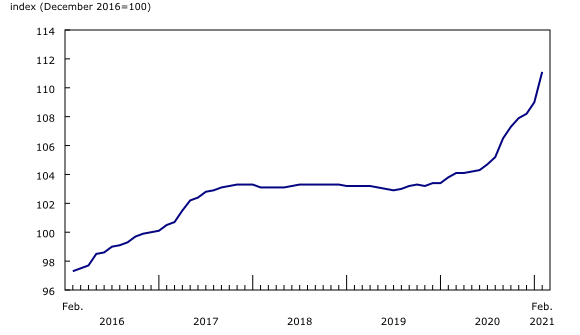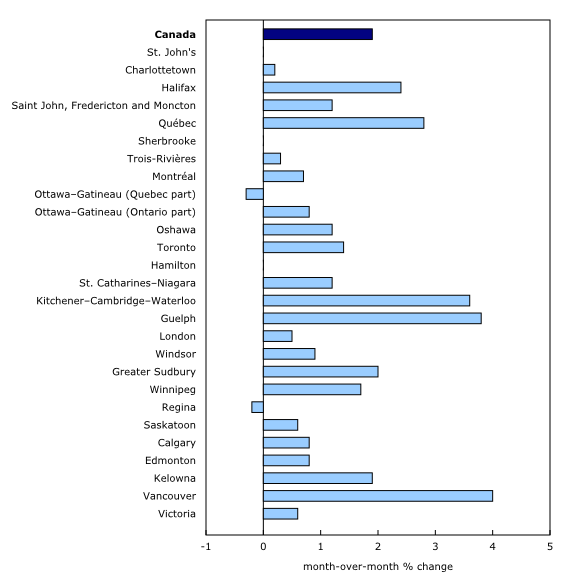New Housing Price Index, February 2021
Archived Content
Information identified as archived is provided for reference, research or recordkeeping purposes. It is not subject to the Government of Canada Web Standards and has not been altered or updated since it was archived. Please "contact us" to request a format other than those available.
Released: 2021-03-18
February 2021
1.9% 
(monthly change)
February 2021
0.0%
(monthly change)
February 2021
0.2% 
(monthly change)
February 2021
2.4% 
(monthly change)
February 2021
1.2% 
(monthly change)
February 2021
0.8% 
(monthly change)
February 2021
1.3% 
(monthly change)
February 2021
1.7% 
(monthly change)
February 2021
0.3% 
(monthly change)
February 2021
0.8% 
(monthly change)
February 2021
3.6% 
(monthly change)
New home prices in February rose at their fastest pace in more than three decades (since February 1989).
New Housing Price Index, monthly change
New house prices were up in 22 of the 27 census metropolitan areas (CMAs) surveyed, pushing the national index up 1.9% in February. Builders in most cities linked the spike to higher construction costs as well as to an active housing market.
Rising construction costs push prices upwards
According to the Canadian Home Builders' Association, the cost of a typical 2 500-square-foot home was up by $30,000 in 2020, as a result of rising construction materials costs, including prices for structural lumber and wood-based structural panels such as plywood. Year over year, softwood lumber was up 108.0%—its second largest price increase ever, the largest having been recorded in January 2021 (+112.2%). Hikes in construction costs were attributable to high demand for home building and renovation projects across North America, coupled with delays in the supply chain due to COVID-19 restrictions. As builders struggled to secure building supplies, fewer lots were released at the same time, which further led to the price acceleration of new houses.
New home prices continued to rise as record low interest rates remained a key driver for housing activity. Furthermore, buyers, including first-time buyers and those looking to upgrade their living arrangements, also added pressure to housing prices in an already low-supply market. Younger Canadians are an important cohort with respect to housing demand, as roughly 12% of Canadians aged 25 to 35 purchased a property during the pandemic.
Vancouver (+4.0%), Guelph (+3.8%) and Kitchener–Cambridge–Waterloo (+3.6%) recorded the largest monthly changes in new home prices.
New Housing Price Index, 12-month change
Nationally, new house prices rose 7.0% year over year in February—the largest increase in over a decade (since July 2007).
Kitchener–Cambridge–Waterloo (+16.0%) registered the largest year-over-year gain in February, displacing Ottawa (+15.0%), which had been growing at the fastest year-over-year pace nationally since May 2018.
Working from home, as well as Kitchener–Cambridge–Waterloo's relative affordability compared with Toronto, has strengthened the demand for larger homes in this housing market. Additionally, the city has one of the fastest growing populations in Canada and a low supply of family-sized condominiums, putting more price pressure on larger detached homes.
Other notable year-over-year price changes were seen in Hamilton and Guelph (both up +11.0%). Both cities offer more affordable housing options than Toronto, while still being in close proximity to Canada's largest economic centre.
The new housing market remained weak in Regina (-0.6%) in February.
Outlook: New house prices will continue to rise in the near term
Structural shift towards working remotely and needing more space at home, combined with low borrowing rates, high construction costs and low housing supply, will continue to put upward pressure on new house prices. Therefore, relatively affordable commutable communities near large urban centres such as Toronto, Vancouver and Montréal are likely to continue to attract buyers looking to capitalize on more flexible work arrangements in their search for larger living spaces.
The continued strength in new housing prices may be an obstacle for some potential buyers to secure a new home. As prices increase, the purchase of a house will become less affordable as bidding wars continue to overheat an already active market.
With the widening price differential between single-family houses and condominium-apartments, potential homebuyers may shift towards condominium-apartments and thus ease pressure on the single-family housing market.
Note to readers
The New Housing Price Index (NHPI) measures changes over time in the selling prices of new residential houses. The prices are those agreed upon between the contractor and the buyer at the time the contract is signed. The detailed specifications for each new house remain the same between two consecutive periods.
The prices collected from builders and included in the index are market selling prices less value-added taxes, such as the federal Goods and Services Tax and the provincial harmonized sales tax.
The survey covers the following dwelling types: new single homes, semi-detached homes and town homes (row or garden homes). The index is available at the national and provincial levels and for 27 census metropolitan areas (CMAs).
The index is not subject to revision and is not seasonally adjusted.
In addition to this monthly release, the NHPI has also been integrated into the Residential Property Price Index (RPPI). The RPPI is a quarterly series that measures changes over time in the prices of residential properties for Montréal, Ottawa, Toronto, Calgary, Vancouver and Victoria. An aggregate for these six CMAs is also available. The RPPI provides a price index for all components of the housing real estate market—new and resale—in addition to a breakdown between houses and condominium apartments.
Products
The article "The resilience and strength of the new housing market during the pandemic" examines the changes in new home prices in Canada for the 27 surveyed CMAs captured in the NHPI and compares the ranking of cities based on prices six months into the pandemic (August compared with February).
The article "Price trends and outlook in key Canadian housing markets" looks at where the housing market was at the onset of the COVID-19 pandemic, sheds light on what has happened since then and explores the challenges of the Canadian market going forward.
The infographic "The impact of COVID-19 on Key Housing Markets," part of the series Statistics Canada — Infographics (11-627-M), is available. It provides an outlook on the housing market before, during and after the onset of the COVID-19 pandemic.
The "New Housing Price Index: Interactive Dashboard," which allows users to visualize statistics on new housing prices, is available.
The "Housing Market Indicators" dashboard, which provides access to key housing market indicators for Canada, by province and by CMA, is also available.
For more information on the topic of housing, visit the housing statistics portal.
The video "Producer Price Indexes" is available on the Statistics Canada Training Institute webpage. It provides an introduction to Statistics Canada's Producer Price Indexes—what they are, how they are compiled and what they are used for.
Statistics Canada launched the Producer price indexes portal as part of a suite of portals for prices and price indexes. It provides users with a single point of access to a wide variety of statistics and measures related to producer prices.
Next release
The New Housing Price Index for March will be released on April 22.
Contact information
For more information, or to enquire about the concepts, methods or data quality of this release, contact us (toll-free 1-800-263-1136; 514-283-8300; STATCAN.infostats-infostats.STATCAN@canada.ca) or Media Relations (613-951-4636; STATCAN.mediahotline-ligneinfomedias.STATCAN@canada.ca).
- Date modified:



